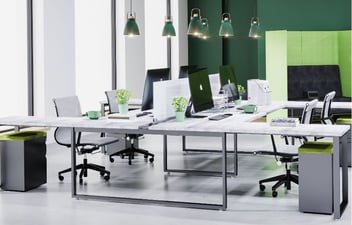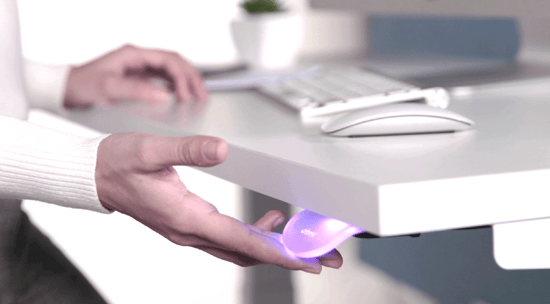The Benefits of Using AI for Custom Office Layouts
The Revolution of Office Design with Artificial Intelligence
The modern workplace is no longer a sea of identical desks under harsh fluorescent lights. Today’s offices are dynamic, collaborative, and tailored to the unique needs of both employees and businesses. Enter artificial intelligence (AI)—a transformative tool that is redefining how offices are designed and managed. With its ability to analyze data, predict outcomes, and enhance creativity, AI is quickly becoming a cornerstone of office design, offering numerous benefits for organizations striving to optimize their workspaces.
Let’s dive into the key ways AI is revolutionizing office layouts and delivering measurable value to businesses.
Enhanced Space Optimization
One of AI’s most significant advantages in office design is its ability to maximize space efficiency.
AI algorithms analyze an office’s dimensions and usage patterns, suggesting layouts that best use available space. For instance, underutilized areas can be repurposed into collaborative zones, private workspaces, or even recreational areas.
This optimization reduces wasted space while ensuring that every corner of the office serves a purpose. AI also enables businesses to adapt layouts quickly to accommodate changes like team expansions or shifts to hybrid work models.
Example: In a dynamic hybrid work environment, AI can analyze foot traffic data to determine which desks are consistently vacant, then recommend converting those areas into shared workstations or meeting pods.
Improved Productivity and Collaboration
AI doesn’t just focus on spatial efficiency—it also enhances the human element of office design by fostering collaboration and boosting productivity.
For example, AI can strategically position teams or departments that frequently collaborate closer together. These layouts minimize distractions and encourage innovation by reducing physical barriers and streamlining workflows.
AI-driven insights also help businesses create focus zones for deep work and lively hubs for brainstorming sessions, ensuring that employees have access to environments suited to their specific tasks.
Personalized and Ergonomic Workspaces
Gone are the days of one-size-fits-all office setups. AI empowers businesses to craft personalized workspaces that cater to individual employees’ preferences and needs.
Tailored Environments: AI can adjust lighting, temperature, and even desk configurations based on each worker’s ergonomic needs. This creates an environment that enhances comfort and reduces physical strain, leading to happier, healthier employees.
Example: Studies show that productivity can drop by up to 76% when office temperatures are too high. AI systems mitigate this by automatically adjusting HVAC settings to maintain optimal conditions.
You might be interested in: Improving Office Energy Efficiency with Technology.
Advanced Data Analysis for Better Design
AI’s ability to process vast amounts of data makes it an invaluable tool for office design. Sensors throughout the workplace can monitor space utilization, identifying areas that are overused or underutilized.
This data-driven approach allows designers to create layouts that align with real-world usage patterns. For example, if meeting rooms are frequently empty, AI might suggest converting them into breakout spaces or informal collaboration zones.
Predictive analysis is another game-changer. AI can simulate how proposed designs will perform in real-world conditions, accounting for factors like traffic flow, lighting, and acoustics. These simulations help identify potential issues early, saving businesses from costly modifications later.
Sustainability and Cost Efficiency
Sustainability is a growing priority for businesses, and AI is paving the way for eco-friendly office designs.
Natural Light Optimization: AI can position workstations and communal areas to maximize exposure to natural light, reducing reliance on artificial lighting.
Energy Efficiency: Smart systems powered by AI can regulate heating, cooling, and lighting based on occupancy levels, minimizing energy consumption and reducing operational costs.
Cost Savings: By minimizing waste during the design process and improving energy efficiency, AI delivers significant long-term savings for businesses.
Enhanced Visualizations for Stakeholders
AI goes beyond data analysis by offering stunning visual representations of proposed office layouts. High-quality renderings and virtual tours allow stakeholders to envision the final design in detail before construction begins.
These visualizations are more than just aesthetically pleasing—they’re practical. They help align expectations, streamline approval processes, and give employees a chance to familiarize themselves with their new workspace before moving in.
Balancing Technology with Human Creativity
While AI offers unparalleled efficiency and insights, it’s essential to remember that technology is only one part of the equation. The best office designs combine AI-driven data with the creativity and empathy of human designers.
AI excels at identifying patterns and suggesting solutions, but human expertise is needed to interpret those insights and craft spaces that feel welcoming and authentic.
Overcoming Challenges with AI
Despite its many benefits, AI is not without limitations. For example:
- Data Privacy Concerns: AI relies on employee data to make recommendations, so businesses must ensure compliance with privacy regulations.
- Regulatory Knowledge: AI tools may not always account for the latest construction and safety standards, requiring human oversight.
By addressing these challenges, organizations can harness the full potential of AI while mitigating risks.
The Future of AI in Office Design
As technology continues to evolve, AI’s role in office design will only grow. From virtual reality simulations to AI-powered project management tools, the possibilities are endless. Businesses that embrace these innovations today are not just optimizing their workspaces—they’re future-proofing their operations for years to come.
If you want to learn more about Office design with AI or know some apps to decorate or design the layout of your workspace, visit Artificial Intelligence for decorating your office: The best 2 apps.
Conclusion: Embrace the Future of Office Design
Artificial intelligence is transforming the way we think about office design, enabling businesses to create smarter, more efficient, and more personalized workspaces. By combining the power of AI with the creativity of human designers, organizations can craft environments that drive productivity, foster collaboration, and support employee well-being.
Are you ready to reimagine your office?





